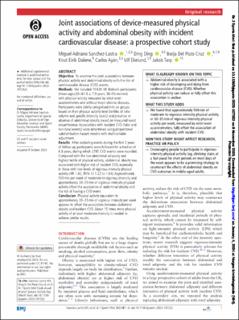| dc.contributor.author | Sanchez-Lastra, Miguel Adriano | |
| dc.contributor.author | Ding, Ding | |
| dc.contributor.author | Dalene, Knut Eirik | |
| dc.contributor.author | Ayán, Carlos | |
| dc.contributor.author | Ekelund, Ulf | |
| dc.contributor.author | Cruz, Borja del Pozo | |
| dc.contributor.author | Tarp, Jakob | |
| dc.date.accessioned | 2024-01-05T08:48:29Z | |
| dc.date.available | 2024-01-05T08:48:29Z | |
| dc.date.created | 2023-11-21T10:46:03Z | |
| dc.date.issued | 2023 | |
| dc.identifier.citation | British Journal of Sports Medicine. 2023, Artikkel 107252. | en_US |
| dc.identifier.issn | 0306-3674 | |
| dc.identifier.uri | https://hdl.handle.net/11250/3110028 | |
| dc.description | This is an open access article distributed in accordance with the Creative Commons Attribution Non Commercial (CC BY-NC 4.0) license, which permits others to distribute, remix, adapt, build upon this work non-commercially, and license their derivative works on different terms, provided the original work is properly cited, appropriate credit is given, any changes made indicated, and the use is non-commercial. | en_US |
| dc.description.abstract | Objective: To examine the joint associations between physical activity and abdominal obesity with the risk of cardiovascular disease (CVD) events.
Methods: We included 70 830 UK Biobank participants (mean age±SD=61.6 ± 7.9 years; 56.4% women) with physical activity measured by wrist-worn accelerometers and without major chronic diseases. Participants were jointly categorised into six groups based on their physical activity level (tertiles of total volume and specific intensity levels) and presence or absence of abdominal obesity based on measured waist circumference. Associations with incident CVD (fatal and non-fatal events) were determined using proportional subdistribution hazard models with multivariable adjustment.
Results: After excluding events during the first 2 years of follow-up, participants were followed for a median of 6.8 years, during which 2795 CVD events were recorded. Compared with the low abdominal adiposity and highest tertile of physical activity, abdominal obesity was associated with higher risk of incident CVD, especially in those with low levels of vigorous-intensity physical activity (HR 1.42, 95% CI 1.22 to 1.64). Approximately 500 min per week of moderate-to-vigorous intensity and approximately 30–35 min of vigorous-intensity physical activity offset the association of abdominal obesity and the risk of having a CVD event.
Conclusion: Physical activity equivalent to approximately 30–35 min of vigorous intensity per week appears to offset the association between abdominal obesity and incident CVD. About 15 times more physical activity of at least moderate intensity is needed to achieve similar results. | en_US |
| dc.language.iso | eng | en_US |
| dc.subject | Body Mass Index | en_US |
| dc.subject | cardiovascular diseases | en_US |
| dc.subject | physical activity | en_US |
| dc.subject | public health | en_US |
| dc.subject | risk factor | en_US |
| dc.title | Joint associations of device-measured physical activity and abdominal obesity with incident cardiovascular disease: A prospective cohort study | en_US |
| dc.type | Peer reviewed | en_US |
| dc.type | Journal article | en_US |
| dc.description.version | publishedVersion | en_US |
| dc.rights.holder | © Author(s) (or their employer(s)) 2023 | en_US |
| dc.source.pagenumber | 8 | en_US |
| dc.source.journal | British Journal of Sports Medicine | en_US |
| dc.identifier.doi | 10.1136/bjsports-2023-107252 | |
| dc.identifier.cristin | 2199393 | |
| dc.description.localcode | Institutt for idrettsmedisinske fag / Department of Sports Medicine | en_US |
| dc.source.articlenumber | 107252 | en_US |
| cristin.ispublished | true | |
| cristin.fulltext | original | |
| cristin.qualitycode | 2 | |
